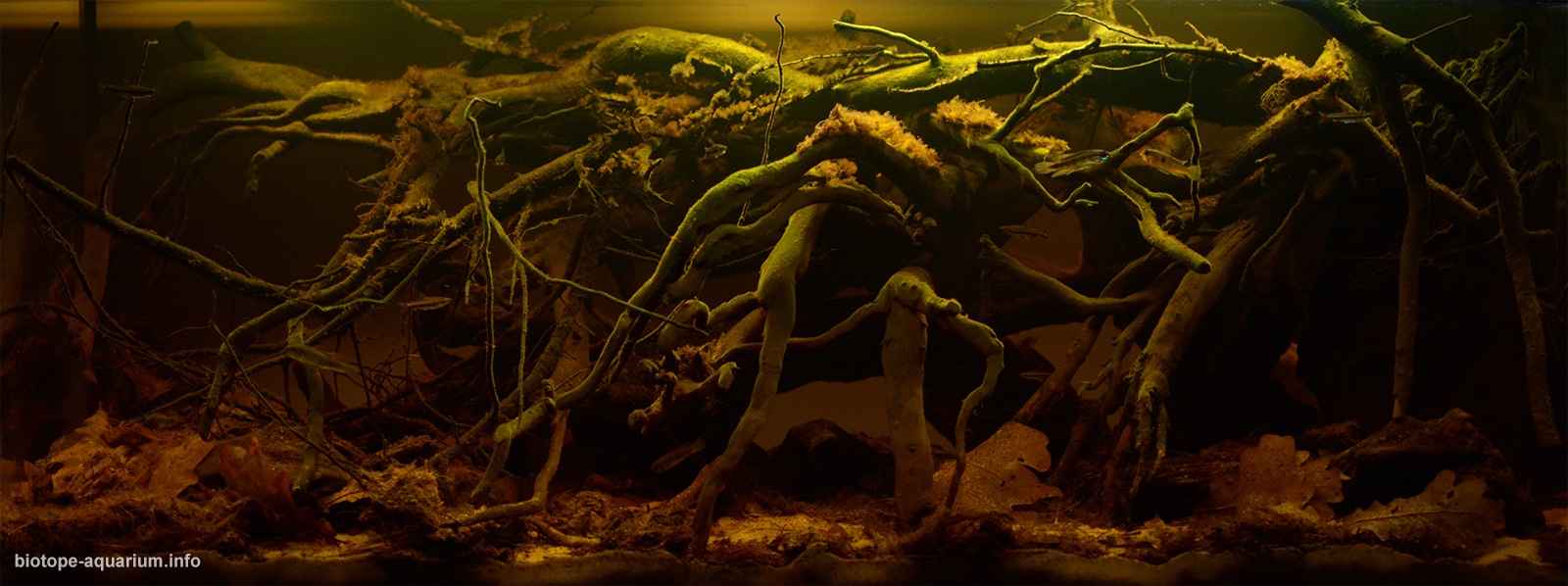The fabulous world of Caño Sardiña, Black Water, Columbia
27th place in Biotope Aquarium Design Contest 2017
![]() Poland. Arkadiusz Skrzycki
Poland. Arkadiusz Skrzycki

Volume: 160 L
Dimensions: 100x40x40 cm
List of fishes: My aquarium is inhabited by Apistogramma Iniridae 2 males and 4 females with 15 Nannostomus Trifasciatus
List of plants: N/A
Description of decorations: Substrate in the aquarium is fine river sand, leaves, roots and the algae that feed on them are the rest of the composition. Arrangement is from the bottom to the water itself, so the Apistogramma fishes swim around the aquarium. The root system gives the fish the ability to divide theterritories in such a way that the fish do not create unnecessary conflicts among themselves.
Description of equipment: Filtration: JBL e901 is bilogical filtration, mechanical filtration Aquael fan3, heater Eheim 150W. Filters are hidden on one side of the aquarium so that the water coming out of the filter flows around the aquarium. Water is aerated through the gentle movement of the water tract.
Water parameters: pH 5, gH 0, kH 0, NOᴣ near zero, conductivity 18 ppm, temperature 28.5 ° C. The water is filtered through the RO filter and additionally passed through DIY peat filter, thereby lowering the pH and giving the color of tea water.
Description of the area surrounding the biotope: Caño Sardiña is a small creek of the right tributary of the upper Caño Bocón, which flows into Rio Inirida in Colombia. Surrounding Caño Sardiña is densely planted with trees. Branches of trees hang down just above the water or even dive into the water. The absence of protozoa, larvae of insects and other aquatic organisms does not mean that fish do not have food. Fallen leaves, fruits and seeds, flying insects and other, smaller fish are excellent sources of food. Because there are usually huge water level fluctuations, between the wet and dry seasons in black waters, parts oftrees that some fish serve as karma are flooded. The most difficult period for fish is dry season. In the flowing waters the sandy bottom is discovered, and the leaves are washed away. Missing places to hide. Water is falling off the leaves and fruits. Fish adapted to these conditions in different ways. For almost all typical behavior, spawning is approached immediately after the onset ofa rainy season that feeds the offspring. January is the least rainfall. The average this month is 59 mm. Most rainy in June, an average of 432 mm. In February, theaverage temperature is 28.2 ° C. In June, the average temperature is 26.2 ° C. This is the lowest average temperature of the whole year.
Description of the underwater landscape of the biotope: Caño Sardiña is a blackwater water system for black southern america waters. In black water we do not find almost any aquatic plants that need light even though the water is clear, because of its color, some light spectrum ranges do not reach greater depths and which do not tolerate such acidic environment. The color and chemical composition of the water is due to the lack of rinsing mineral substances and the accumulation of huge amounts of organic matter in the water. These are mainly leaves and fruits falling from the trees and rinsed during the rainy season. Branches of trees and their roots come out of the shores and are submerged in water. They rot and give off tannins and humic acids – substances that acidify and brownize the water. The bottom of the water reservoir is usually sandy, but covered with a thick 20-30 cm layer of rotting plant particles. There is plenty of decayed wood in the water. We will not find any rocks or stones here. In black waters, it is difficult to survive any organisms, including fish. These, however, found ways to efficiently eat, they also used the sterility of water. The absence of protozoa significantly reduces the possibility of various diseases. Roots and rotten leaves provide excellent hiding places against predators. Some fish live even in the rotten part of plants covering the bottom of reservoirs.
Description of the parameters of the habitat: Black South American waters have tea color, are very clear – visibility up to 3 meters, very acidic to moderate – pH between 3.5 and 6 is changing between the rainy season and dry, in Caño Sardinia in February recorded a pH of 4.8, and extremely soft – conductivity 19 μs/cm. The chemical content is traceable. You can say that they are almost sterile.
List of fishes: In black waters we find various fish bred in aquariums. There are both: very small and very large species. Most of them belong to two families: tetras and cichlids. Black water fish are usually small, very colorful species of herds. Examples are Paracheirodon or Nannostomus. The most common inhabitate are small streams. It is believed that the vivid colors of black-spotter fish help them recognize other individuals of their species. Fish and organisms occurring in Caño Sardiña: Poecilocharax weitzmani, Crenuchus spilurus, Elachocharax, two other species Carnegiella : C. strigata and C. marthae, Iguanodectes, Nannostomus trifasciatus, Cardinal tetras, Paracheirodon axelrodi, Crenicichla, Apistogramma Iniridae, catfishes, small species Farlowella and also a very beautiful shrimps.
List of plants: N/A
Sources of information:
- www.practicalfishkeeping.co.uk/features/
articles/Heiko%20Bleher% 20discovers:%20Apistogramma? rq=apistogramma%20inirida - https://en.climate-data.org/
location/4655/ - http://www.apisto.pl/index.
php?option=com_content&view= article&id=9:czarne-wody- tropikalnej-ameryki- poudniowej&catid=7:typowe- biotopy&Itemid=11
Comments of the members of the jury of Biotope Aquarium Design Contest 2017

This aquarium is one of those rare biotopes that I can find harmoniously in its complexity. The fish, light and design trio complement each other very well. Even if the aquarium sizes are not very suitable for design, this aquarium is a great example for everyone to see to how the occupancy rate can be achieved in like similar aquaria. Although you have reduced your aquarium volume with your design, keeping the number of fish few was a very accurate decision. Photography and video are also very successful. This aquarium was one of my favourite biotope in this contest. It is a very good work, congratulations.
